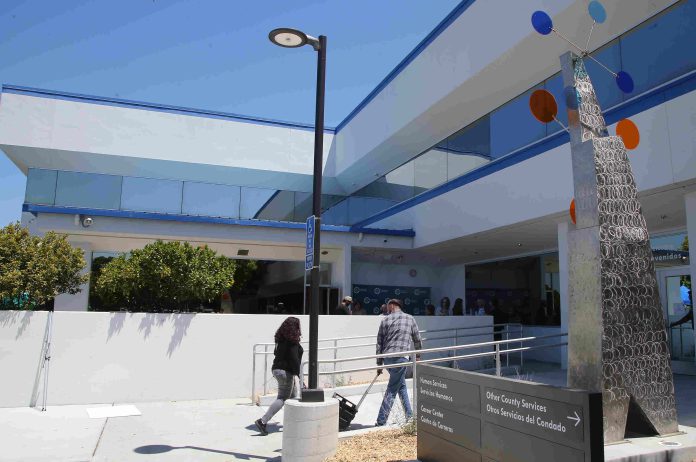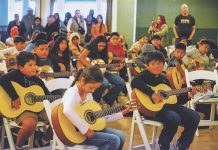
About 40,000 Santa Cruz County residents who depend on Medi-Cal—more than half of the 78,000 people with that coverage—could lose it after the passage of H.R. 1—President Trump’s One Big Beautiful Bill Act (OBBBA).
That was the message Tuesday from Santa Cruz County Human Services Director Randy Morris, who said those effects—along with more than 7,000 people who could lose their Calfresh benefits—were put in place so that OBBBA can provide tax cuts to the nation’s wealthiest people and $170 billion for federal immigration enforcement.
“That is the United States of America today,” Morris told the county Board of Supervisors during the meeting, during which they heard a report on how OBBBA will affect residents and the services upon which they depend.
The grim discussion was compounded by the looming shutdown of the federal government, which became a reality at midnight Wednesday.
The shutdown
While House Republicans presented a bill that would have funded the government through Nov. 21, Senate Democrats insisted on additions such as health care premiums. Republicans refused, talks stalled and forced the shutdown.
Local effects
Assistant County Administrative Officer Elissa Benson said that, while the Executive Branch ultimately decides on what specific services will stop, she said that a slowdown of federal reimbursements is the most likely outcome.
“That cash that we expect to come in on a reimbursement level may dramatically slow down,” she said.
The county is now working with its various departments to see how the county can continue paying its bills and providing services while working within the constraints of reduced revenues, Benson said.
But those decisions can be tricky, since the cuts imposed by OBBBA will keep coming over the next four years, affecting the “fundamental things that human beings need to live- health care and food,” requiring the county to continually adjust and respond over multiple years, Benson said.
“The easiest way to summarize this is, it is the phased deconstruction of the safety net and health care system in this country,” she said.
Among other things, OBBBA also imposes stricter—and more frequent—eligibility requirements for CalFresh benefits, removes Medi-Cal benefits for children under 5 considered “unsatisfactory immigration status” or “lawful permanent residents,” and slashed in half the federal contribution for Medi-Cal benefits.
In addition to cuts to medical and food aid, OBBBA will have sweeping effects on other nonprofits that provide services to low-income people.
Second Harvest Food Bank CEO Erica Padilla-Chavez said that, with the cancellation of SNAP benefits and a $100,000 decrease in federal funding, increasing numbers of people will be seeking ways to feed their families.
“We’re going to see, and food banks across the nation are preparing, to become the first line of defense against food insecurity,” she said.
In addition, an estimated 13,000 people already struggling to make ends meet will see an increase in their health insurance premiums, said Health Improvement Partnership of Santa Cruz County Executive Director Maritza Lara.
“As we all know, the moment someone has to decide between food and insurance they may need this month or in a couple of months, a lot of folks may decide that this is not worth to pay and say, we are disenrolling as a family,” she said.
Tony Nuñez, who serves both as spokesman for Community Bridges and Board Chair of Pajaro Valley Health Care District, said that fewer people will have access to health insurance, but will still seek medical care in emergency rooms, leaving hospitals to foot the bills.
“That sets off a real awful chain of impacts,” he said. “Insurance rates will likely go up. As a result, some services will be cut from health care providers. Access will be lost for people across the county, and people will suffer. People are going to be less healthy, people are not going to get the care they need in order to be at work, at school and everywhere else they need to be.”
Supervisor Monica Martinez said that many people in the community have spent their careers building a safety net for the most vulnerable.
“And we’re seeing a dismantling of that right before our eyes,” she said.
Supervisor Manu Koenig said that the report should serve as a “tsunami warning for the community.”
“This really is going to take new and creative ways of thinking and working together in order to address this problem,” Koenig said. “The only way we’re going to get through it is working together hand-in-hand.”
- Infobox
- Other impacts of the shutdown
- • Air traffic controllers – These employees are considered essential and will keep working, although they will not be paid. More than 11,000 employees at the Federal Aviation Administration face layoff if funding runs out.
- • The Mail – Because the United States Postal Service is self-funded, the mail will still continue.
- • Benefits such as WIC, SNAP and Social Security – These will continue, although payments may be delayed.
- • Federal workers – As many as 750,000 federal workers and active-duty military members will not receive paychecks during the shutdown.
- • National Parks – While furloughs are expected for the majority of the National Park Service’s 16,000 employees, the Trump administration has signaled that it will use park entrance fees to keep the gates open and fund skeleton crews at the majority of parks.
This story has been updated to reflect Supervisor Monica Martinez’s correct name.













Great job, trump voters! I’m sure most of you consider yourselves Christian, too.
Well I am going back to Mexico next month and taking my family with me. The US will pay for my flight and give me good money to leave. I can go anywhere in Mexico I want and with the 5 thousand they give me I can start a business in my home. No police and no ICE trouble
It was nice here for the past three years but now it pays to go home. Then I coming back after trump. He just start soon he will deport all in California. They getting 10 thousand more ICE now going to be better to leave now before the arrest. Also tired of hiding in my home here from ICE can make no money here now
Have a nice trip
Well………bye.
We would not need to spend $170 billion for federal immigration enforcement, if the dem’s would have not openend the borders so they could win elections down the road and for greedy american company’s to have cheap labor. Not to mention 25 million illegals have driven the cost of housing through the roof.
Total BS. By the way, I received my new property tax bill, and I have to pay 500 more a year on my income which isn’t going up that much as I’m retired. Although I support legal immigration, illegal immigration means we pay for those that don’t have health insurance, and pay more for PVUSD to educate the kids in two languages. I’m sick of it. My ancestors came to Santa Cruz legally from another country, not Mexico, and within 7 years they were American citizens who could read, write and speak English. We’re tired of people illegally coming to the US, sucking our resources, getting free education and getting paid a higher wage for being educated to be bilingual on our dime, than those that only speak English. City of Watsonville pays more to people who are bilingual and screws English only kids looking for work. Look at your tax bill and see how much we pay to the schools and Watsonville hospital. I don’t get free anything unlike those that sneak into our country illegally. I’m not and never will be a Trump supporter, but It’s getting to be too much doing with out things while our taxes pay for the illegal moochers.
You haven’t been following the government shutdown, have you? The trump administration is trying to cut Medicare and Medicaid for millions of American citizens. The Democrats voted against that, hence the shutdown. The mere fact that you’re talking about immigration instead of talking about millions of citizens losing their health care means that you’ve already fallen for the red herring.
RV “Reading is Fun if You Know How,” We would not need to spend $170 billion for federal immigration enforcement, if the dem’s would have not openend the borders. Think of all that money spent on the legal citizens of the United States, instead it’s bing spent to deport illegals.